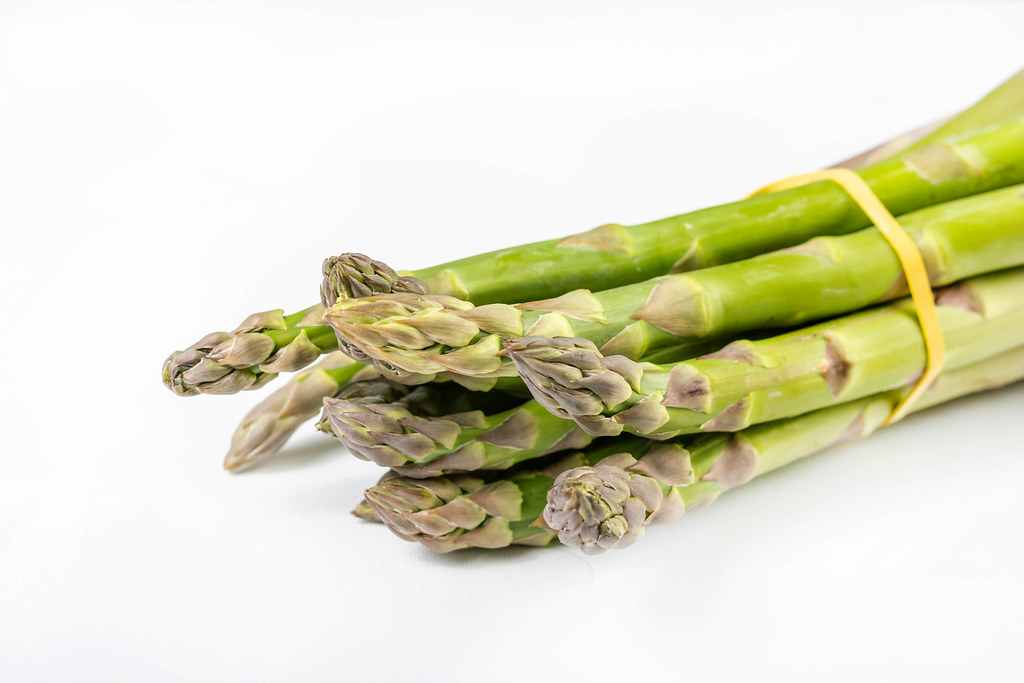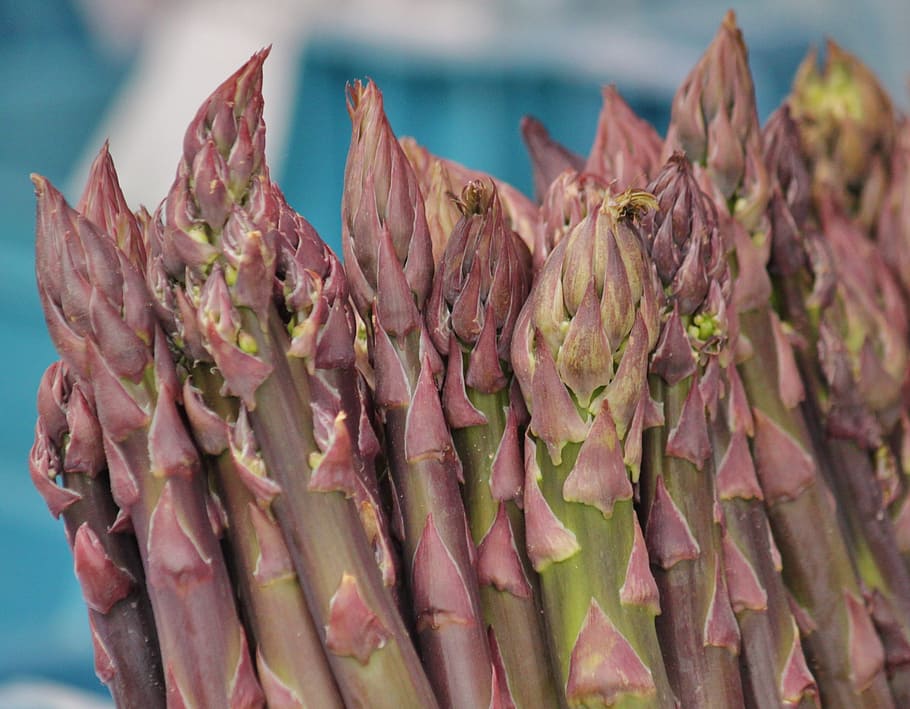
Asparagus is one of our favorite vegetables because it is so easy to prepare. You can have it raw or cook it in various styles. Its mild flavor goes nicely with lots of foods, like being a part of a salad or a side dish. Some people also love to toss it into soups and stews.
Describing how asparagus tastes can be tricky. For example, a few individuals discover it slightly sweet, whereas others perceive a touch of bitterness. But don’t worry! We have covered this topic in detail so you can find the perfect taste of Asparagus!
What Does Asparagus Taste Like?
Asparagus comes in around 300 different kinds. The top four are green, purple, white, and wild asparagus. Let’s understand the taste of each type of asparagus.
Green Asparagus
The most common form of asparagus is Green Asparagus which grows in cooler places. It has a taste like grass and earth, sort of like green beans and broccoli stems. It’s heartier in flavor than white asparagus and grown above the ground. Green asparagus holds onto its tips as it grows, getting its green color from chlorophyll. This kind has a lot of antioxidants that are good for your health.

Keep in mind that this grassy note is found in young and tender spears and contributes to the vegetable’s fresh and vibrant flavor profile.
Besides, green asparagus can sometimes taste a little bitter, especially in the thicker part of the spear. This bitterness is stronger than what you find in white asparagus. White asparagus is less exposed to sunlight while it grows, which makes it less bitter.
If you cook it right, you’ll be delighted by the taste even more. When cooked properly, the spears retain a satisfying crispness and crunch, contributing to the overall sensory experience.
White Asparagus
White asparagus is renowned for having a milder, less pronounced bitterness compared to green asparagus. The bitterness, which is a result of compounds like terpenoids and phenolic compounds, is subdued in white asparagus due to its lack of exposure to sunlight during growth.
Apart from that, one of the most notable differences in taste between white and green asparagus is the heightened sweetness in the former. The absence of chlorophyll development due to the lack of sunlight leads to lower levels of certain compounds that contribute to bitterness, allowing the natural sweetness to shine through.

Note that white asparagus can exhibit a subtle nutty undertone in its flavor profile. This flavor note, combined with its inherent sweetness, contributes to its overall complexity.
It originally comes from France, Germany, the Netherlands, Switzerland, Spain, and Greece. When you put it side by side with green asparagus, you’ll notice that it has a slightly sweeter taste and a softer texture. One research reveals that people tend to consume it more than green asparagus due to its delightful taste.
Fun Fact: White asparagus tastes great with melted butter too! The buttery richness complements the delicate flavor and enhances the overall taste experience.
Purple Asparagus
The purple variety of asparagus offers a slightly sweeter and nuttier taste than the green type. Its distinctive color comes from anthocyanins. Anthocyanins are powerful antioxidants found in foods that have protective and preventive health benefits. They can help reduce inflammation and lower the risk of cancer.
Purple asparagus is often noted for its mild sweetness. The natural sugars present in this variety contribute to its sweeter taste compared to other forms of asparagus. Besides, purple asparagus has a more delicate aroma compared to the strong sulfurous scent associated with green asparagus or white asparagus. This can contribute to a more refined and pleasant sensory experience.

It is important to keep in mind that purple asparagus has a nuttier taste compared to its green counterpart.
Moreover, purple asparagus holds more folic acid, which is an important nutrient for pregnant women. If you are expecting or planning to have a baby, this veggie could be a smart pick! It is also a source of antioxidants that help fight inflammation and guard against certain types of cancer.
Wild Asparagus
Now, there is also wild asparagus in the picture (also known as (Asparagus prostratus or Asparagus acutifolius). Though it belongs to the same family, it is a bit different when it comes to the taste and texture.

Wild asparagus offers an earthy and slightly bitter-sweet flavor akin to its cultivated counterpart. Sometimes, wild asparagus can have a little extra earthy taste and a touch of bitterness. This is because it grows in different places with different kinds of soil.
This version grows with the help of insects as spotted in Western Europe and Britain.
Factors that Affect the Taste of Asparagus

Asparagus tastes interesting and balanced by mixing different flavors. It holds a touch of bitterness and earthiness with a hint of sweetness as well. But, to understand this concept even better, consider the numerous aspects which impact the taste of Asparagus:
Varietal Differences
Different varieties of asparagus can have varying taste profiles. Some might be sweeter, more tender, or have distinct flavor notes due to genetic differences (We have discussed this in detail below).
Age and Maturity
Younger asparagus spears are generally tender and have a milder taste compared to older, thicker spears. The age at which the asparagus is harvested can impact its texture and flavor.
Harvesting Time
Asparagus harvested at different times during its growing season can have different taste characteristics. Early spring asparagus tends to be more tender and sweet, while later season asparagus might be thicker and have a slightly stronger flavor.
Storage Duration
The longer asparagus is stored after harvest, the more its sugars can convert into starches. Fresher asparagus generally has a sweeter and more pleasant taste as compared to Asparagus that is stored longer than the harvest.
Seasoning
The seasonings can enhance or change the natural taste of asparagus. Asparagus has a flexible flavor that tastes well with various herbs, sauces, and spices. Think of ingredients like salt, pepper, garlic, lemon juice, butter, olive oil, vinegar, cheese, cream, mustard, or soy sauce. Feel free to experiment and combine seasonings to craft your unique asparagus taste.
Freshness
Asparagus tastes best when it’s fresh and in season. Right after being picked, it’s crisp, tender, and brings a delightful taste. Sadly, its goodness and flavor start to fade away soon after harvesting.
To hold onto that goodness, make sure to store and enjoy your asparagus within a few days. And if you choose frozen or canned asparagus instead, keep in mind that they might not be as intense in flavor and could have a gentler texture compared to the fresh ones.
Cooking Method
The way you cook asparagus makes a big difference in its taste. Different cooking methods bring out different flavors and textures. You have options like boiling, steaming, roasting, grilling, or sauteing. Boiling and steaming are easy, but overcooking can make the asparagus soggy.

Roasting, grilling, or sauteing can make it crispy and more flavorful, but you must be careful not to dry it out or burn it. Cooking time varies depending on the thickness of the spears (it usually ranges from 5 to 15 minutes).
Note: The texture can also change depending on how you cook it. If you roast or saute asparagus, it gets firmer and crunchier. Boiling or steaming makes it softer and tender, so it’s smooth and chewy when you eat it.
Suggested Reading: 5 Reasons to Put Ice Cube on Burger While Grilling
Signs to Identify Bad Asparagus
When asparagus is fresh, it brings a gentle and slightly bitter taste that’s quite delightful. But if it goes bad, it turns sour and not so pleasant. Eating spoiled asparagus might even give you tummy troubles like nausea, diarrhea, and stomach aches.
Now, here’s the thing – figuring out if asparagus has gone bad isn’t always as easy as with other veggies. So, it’s important to stay watchful. If your asparagus shows any of these signs, it’s time to say goodbye to it.
- Mold Growth: When mold starts to appear on the asparagus, especially from the tips down the stalks, it’s a clear sign of spoilage.
- Color Changes: If your asparagus changes from its usual green, white, or purple hues to yellow, it’s likely gone bad.
- Unpleasant Odor: Fresh asparagus doesn’t have a strong smell as mentioned above. If you detect an unusual or foul odor, it’s best to avoid eating it.
- Slimy Texture: The tips of asparagus might become slimy or dark green to black, which indicates spoilage.
Tips on Improving Asparagus Flavor
For those who find asparagus too grassy in taste, no worries! We have some easy tips to make asparagus tastier and reduce its grassy flavor.
- When picking asparagus, check for any signs of spoilage like discoloration or slimy tips. Choose bunches that stand upright and have consistent-sized stalks.
- To preserve the freshness and flavor of asparagus, explore diverse storage methods such as refrigeration, freezing, pickling, or canning. Each method gives a unique result.
- Before cooking, make sure to prepare your asparagus properly. Wash it and trim the tough bottom part for better texture.
- Using fresh-tasting butter while cooking can enhance the flavor and aroma of asparagus. If you have leftover butter, store it in quality butter keepers to keep it tasting great.
Suggested Reading: Ultimate Guide to 13 BEST Restaurants In Montclair NJ
Facts About the Taste of Asparagus
Following are 8 known facts about the taste of asparagus:
- Sulfurous Undertone: Asparagus is known for its distinctive sulfurous aroma, which can give it a unique and sometimes pungent flavor. This is attributed to compounds like methanethiol, responsible for the characteristic smell that occurs when asparagus is digested.
- Bitter-Sweet Complexity: Asparagus can exhibit a balance between bitterness and sweetness in its taste profile. The bitterness is more pronounced in thicker spears, while the sweetness is more prominent in the tender tips.
- Umami Enhancer: Asparagus contains glutamate, an amino acid associated with the fifth taste sensation, umami. This contributes to its ability to enhance the overall flavor of dishes when combined with other ingredients.
- Earthy Undertones: Asparagus can have earthy undertones in its flavor, which are more noticeable in wild or freshly harvested asparagus compared to commercially grown varieties.
- Textural Transition: The texture of asparagus can vary along its length. The lower, thicker part tends to be more fibrous and chewy, while the upper, thinner portion is more tender and delicate.
- Freshness is Key: The taste of asparagus is at its best when it’s freshly harvested. The longer it’s stored, the more its sugars turn into starches, affecting its sweetness and overall flavor.
- Slight Nuttiness: Some people detect a subtle nutty undertone in the taste of asparagus, particularly when it’s grilled or roasted. This flavor note can add complexity to various culinary preparations.
- Grassy and Herbal Nuances: Young asparagus spears can carry hints of grassiness and herbal flavors. This is especially true in early spring when they are in season and have a more pronounced freshness.
Read Next: 10 Mouth-Watering South Indian Food Spots in Seattle

Conclusion
Asparagus, a nutrient-rich vegetable, offers a combination of health benefits and a unique taste. The asparagus taste is a delightful blend of earthiness and mild bitterness, often enhanced when cooked. The distinct flavor and versatility of asparagus make it a valuable addition to both health-conscious diets and culinary adventures. Try it out in your culinary dishes and you’ll be really impressed!
What Does Asparagus Taste Like? - FAQs
Green asparagus has a slightly bitter-sweet flavor with earthy undertones, offering a balance between bitterness and sweetness.
White asparagus has a milder and slightly sweeter taste compared to green asparagus, often accompanied by a more tender texture due to its growing method.
Purple asparagus is generally sweeter than green asparagus and has a slightly fruity undertone alongside the traditional earthy flavor. Its vibrant color hints at the unique taste experience it brings to dishes which makes it a visually appealing and delicious option.
Wild asparagus’ flavor is marked by earthiness and a slightly bitter-sweet profile, reflecting its natural environment.
 Reviewed by
Reviewed by ![What To Wear To a Drag Show? [HOTTEST Outfit Ideas]](https://hopdes.com/wp-content/uploads/2024/01/What-to-wear-to-a-Drag-Show-390x220.jpg)



![What to Wear to an Outdoor Concert? [Cute Outfit Ideas]](https://hopdes.com/wp-content/uploads/2023/11/What-to-Wear-to-an-Outdoor-Concert-Cute-Outfit-Ideas-390x220.jpg)

